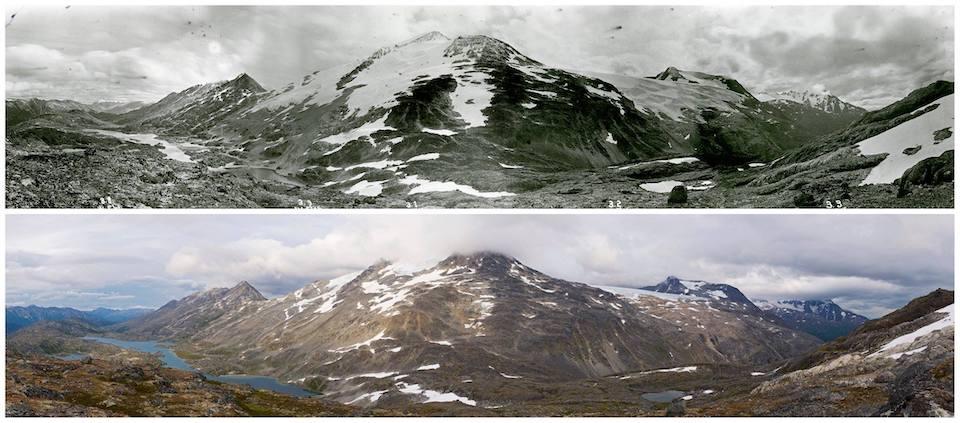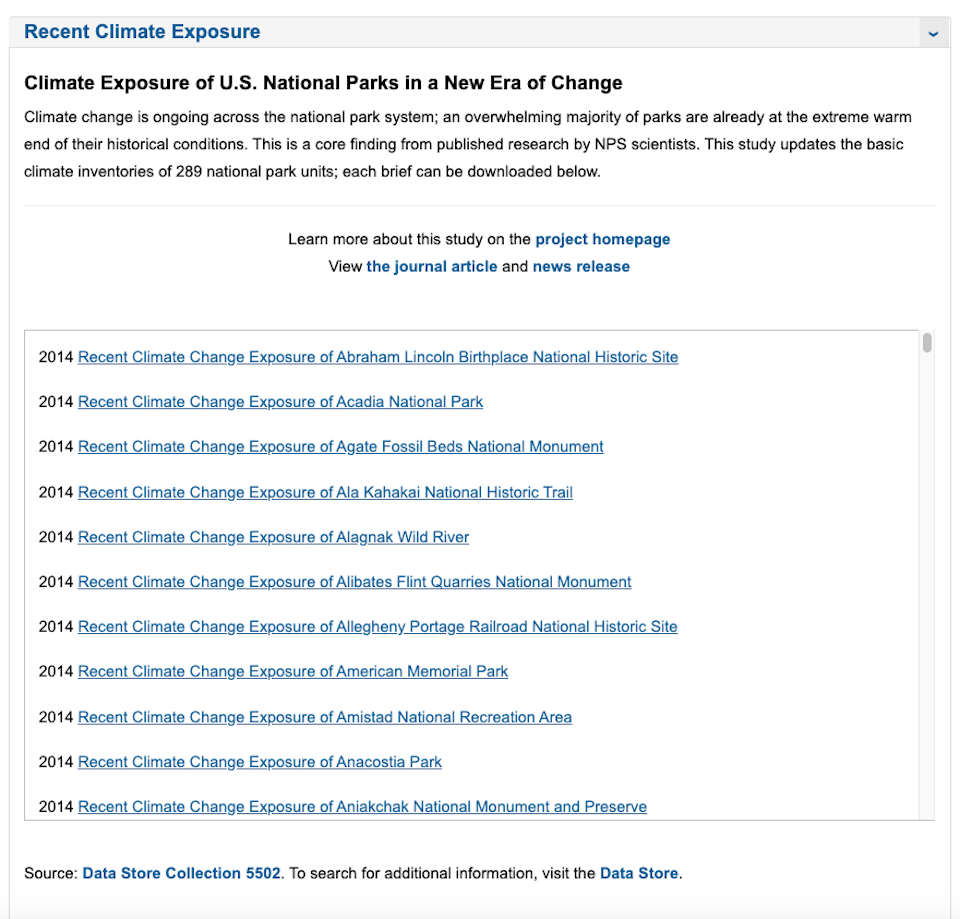
The impacts of climate change can been seen around Chilkoot Pass at Klondike Gold Rush National Historical Park, as these photos taken 108 years apart illustrate. But is the Park Service staying on top of climate change research as it has in the past?/NPS
Editor's note: This updates with response from Jeremy Barnum, the National Park Service's acting assistant director for communications.
Climate change research and reporting in the national parks have virtually stalled.
By Kim O’Connell
Dr. Maria Caffrey was on maternity leave, understandably focused on her newborn, when she received an alarming email from a National Park Service colleague. In Caffrey’s absence and without her input, according to the colleague, senior NPS officials were scrubbing all references to anthropogenic climate change—that is, “human-caused”—from a comprehensive report on how climate change was affecting the national parks for which Caffrey, a climate scientist, was the primary author.
By early 2017, Caffrey had spent four years collecting and analyzing data on sea level rise and storm surge estimates for 118 coastal parks. She had shepherded the ensuing report through scientific peer review and prepared for its publication, but months went by with no release. Only when she received her colleague’s email did she learn that NPS leadership was considering her report at all. That proved to be just the beginning of a months-long battle to daylight the report, evidence of what insiders and observers alike say is an agency-wide clampdown on research and reporting about climate change.
Without research that can undergird planning, parks remain vulnerable to a range of climate-related threats, including flooding, wildfire, drought, erosion, and damaged cultural resources, according to studies. A 2019 report from the National Parks Conservation Association found that climate change was a significant concern for 80 percent of all national park units. And last year, scientists from the University of California at Berkeley and the University of Wisconsin published a study that found that climate change had disproportionately affected many national parks and would continue to do so. Between 1895 and 2010, they determined, the mean annual temperature of the national parks increased at double the rate of the rest of the United States.

Dr. Maria Caffrey, who conducted climate change research for the National Park Service, says she was forced out of the agency.
This is the kind of deep research that Caffrey was doing and wanted to keep doing for the parks, she says. Her 90-page report included several key findings. Among them was a prediction that the National Capital Region of the Park System would experience the highest sea level rise of any park region by 2100—more than two feet. This scenario could potentially inundate, damage, or even destroy low-lying cultural sites including the Jefferson and FDR Memorials and portions of the National Mall. The shoreline near the Wright Brothers National Memorial on North Carolina’s Outer Banks would face an even greater sea level increase, the report states.
“I had a good feel for what the parks need and had built up relationships with those parks,” Caffrey says. “What I would’ve liked to have done next is to go to these parks [for further research], to narrow down the recommendations in the report even more.”
But that didn’t happen.
According to reports, the Trump administration has publicly and privately undermined the work of climate and weather scientists in various ways. For one, President Trump himself has called climate change a “hoax” and “nonsense,” and that he is “not a big believer” in anthropogenic effects. Recently, he made headlines for touting a map of Hurricane Dorian’s path that had been obviously altered to include Alabama, which the president had erroneously said was at risk. It was later revealed that administration officials had pressured National Oceanic and Atmospheric Administration staff to publicly support the president’s take, despite its falsity.

Recent climate change research by the National Park Service seems lacking. This screenshot was captured Nov 1, 2019/NPS
Other examples abound: The Columbia University School of Law’s Sabin Center for Climate Change Law tracks federal, state, and other actions to “silence science.” In the last two years, according to the center, two other land agencies, the Bureau of Reclamation and the U.S. Forest Service, have removed references to climate change from the WaterSMART program and a wilderness website, respectively. Government scientists have also been prevented from testifying before Congress, and other federal reports have edited out references to climate change or its human causes as well.
In 2018, reporter Elizabeth Shogren published a series of articles about the roadblocks Caffrey faced in Reveal, part of the Center for Investigative Reporting. This led members of Congress to press the Interior Department to open an inquiry about the status of her report. Under increasing pressure, the Park Service finally published Caffrey’s full, unedited report last year, including the term “anthropogenic.”
But the situation was far from over. Caffrey says she faced retaliation from her superiors in the form of pay cuts and demotions over the ensuing months. In February 2019, the agency did not renew her funding and denied her subsequent request to work on a volunteer basis, and Caffrey has now filed a whistleblower complaint against the administration. Although she is still researching and publishing on climate science on her own, as far as the national parks are concerned, she says, “I’ve been cut entirely out of the loop.”
As for other ongoing climate change work, the NPS maintains a website about climate change that includes material on climate science and videos about climate change affects certain parks, but most of the material is dated between 2015 and 2017. An interactive sea-level rise viewer that Caffrey helped to develop is online as well. But beyond that, it’s not clear what new initiatives might be occurring.
Jeremy Barnum, the Park Service's acting assistant director for communications, said Monday in an email that the agency "is confident in the quality and accuracy of the science behind the sea level rise and storm surge projections presented in the report. The report underwent several rounds of internal and external scientific peer review to ensure that it is most helpful and relevant to the intended audience of park managers and planners, and accurately portrays scientific understanding of how a changing climate and associated sea level rise can affect national park infrastructure, facilities, and resources."
He added that "our work to understand how climate change affects park resources and infrastructure is part of our core responsibility to protect parks. This project was part of that work, and the National Park Service staff involved performed their responsibilities with the utmost professionalism."
Barnum also pointed out that Caffrey wasn't a Park Service employee, but rather was employed by the University of Colorado to work on the project for the Park Service. When the five-year agreement ended, it was not renewed, he said. Following that project, she was hired for a year-long project involving wetlands management, he said.
Former NPS Director Jon Jarvis, who was nominated by President Obama and retired from federal service just before the Trump inaugural, says significant time has already been lost in the fight against climate change in the parks. “Even back in 2003 to 2005, the parks were already seeing significant changes – fires burning longer, glaciers melting, animals showing up that shouldn’t be there, and animals not showing up that should be there,” says Jarvis, now executive director of UC-Berkeley's Institute for Parks, People, and Diversity. “Science and monitoring are so important, because parks are the canary in the coal mine.”
During his directorship, Jarvis worked to incorporate climate change into park research, interpretation, maintenance, and planning. Under his watch, NPS released its Green Parks Plan first in 2012 and then in updated form in 2016, which outlined several steps parks could take to increase sustainability and resilience.
“We created a ‘no regrets’ plan—simple things like siting of new buildings, making sure new buildings were above the expected sea level rise, and ensuring landscape connectivity,” he explains. “All of that was under way, very aggressively. All that effort was halted with the arrival of the Trump administration. Most of that effort at the leadership level has just stalled, and nothing new is happening.”
Dr. Marcy Rockman is another casualty of the “changing climate” in upper-level NPS management. Until last November, she served as the agency’s climate change adaptation coordinator for cultural resources, basically the only person working on the high-level NPS climate change team that was specifically tasked with determining how climate change would affect historic structures, burial grounds, and the like.
Rockman was the lead author of a climate change strategy paper devoted to cultural resources that was released in January 2017 and became the most downloaded federal document in a single day not long afterwards (holding even with views of Yellowstone’s Old Faithful cam at one point, Rockman says).
“People were worried that it was going to be taken down,” Rockman says. “There were thousands who downloaded it who may not have known that cultural resources and climate change were a thing. It was able to hit that many eyeballs.”
Over time, Rockman came to feel that her work was not adequately supported or funded when compared to natural resources, and that she further endured harassment based on her gender. She resigned last November, publishing her resignation letter on Twitter, and filed a gender harassment complaint against the agency. Nearly a year later, her position has not been filled. Meanwhile, coastal cultural resources remain at risk.
Rockman is now working for the International Council on Monuments and Sites (ICOMOS) to improve incorporation of heritage into reports issued by the Intergovernmental Panel on Climate Change (IPCC). But sending scientists like Caffrey and Rockman to work outside the National Park Service instead of within it, and keeping others from testifying or talking to the public, is a concerning trend, environmental advocates say. The Park Service’s ongoing $12 billion maintenance backlog still exists, too.
Despite the uncertain environment, Jarvis says that he believes national park managers are still doing important and necessary work, simply because ongoing park management efforts like choosing energy-efficient lightbulbs or restoring freshwater flows all help to mitigate and protect against climate change.
“The mission of the National Park Service is long term, determined by the 1916 Organic Act and other laws,” Jarvis says. “We don’t flip direction every four years.”



Comments
In the words of Aron Rogers R-E-L-A-X. I am glad that Dr. Caffrey let us know that East Potomac Park and the Jefferson Memorial were prone to sinking - that whole area is built on fill from the early 20th century. Not sure that is cutting edge science but at least we know now!
My concern is we are making marytrs where we donn't need to have maryrs. Our whole society is either one side or the other and we have abandoned any rational, pragrmatic and productive discussion. There are practices in place right now - and on a daily basis in the Naitonal Park System - that account for climate change. How and where we build our facilities for example. Or better yet, why we shouldn't build facilities when they have been lost to storms, erosion etc. The world of science has not ended in the NPS because of the current administration. Maybe we have less glossy publications than we had before but it is not the "all or nothing" proposition many make it out to be.
Pastor Martin Niemoller once lamented, "First, they came for the socialists and I did not speak out, because I was not a socialist. Then they came for the trade unionists and I did not speak out, because I was not a trade unionist. Then they came for the Jews and I did not speak out, because I was not a Jew. Then they came for me and there was no one left to speak for me." When it all began, Pastor Niemoller never imagined where he would end up. He was a champion of what he saw as a rational, pragmatic, productive new political movement that would "drain the swamp" and make his country great again. Initially, he did not see anything in the new and more orderly approach that was any kind of "all or nothing" proposition, at least not for him. Although the new people in power seemed very critical of scientists and intellectuals in general and they did seem prone to alternative facts and different, sometimes even bordering on the occult, religious and racial beliefs, he certainly didn't see how anyone could believe that the "world of science" was ending. But, day by day, from a seemingly benign beginning to a ultimately grotesque end, things changed, apparently the change was too gradual and subtle for Pastor Niemoller to notice before it was too late.
No, we don't need to have martyrs; but, I'm pretty sure Dr. Caffrey and her colleagues, along with many others who have suffered the same fates over the years of this twisted regime, believe that martyrs truly have been made. As for all those "glossy publications" that smarty pants scientists keep churning out when they should be writing about happy things, like choo choo trains, maybe it's time to put on our official party caps, hold a big torchlight march, and burn all those annoying little books in a big bonfire to give all of us who believe in the new order an inspirational ending to a fun evening.